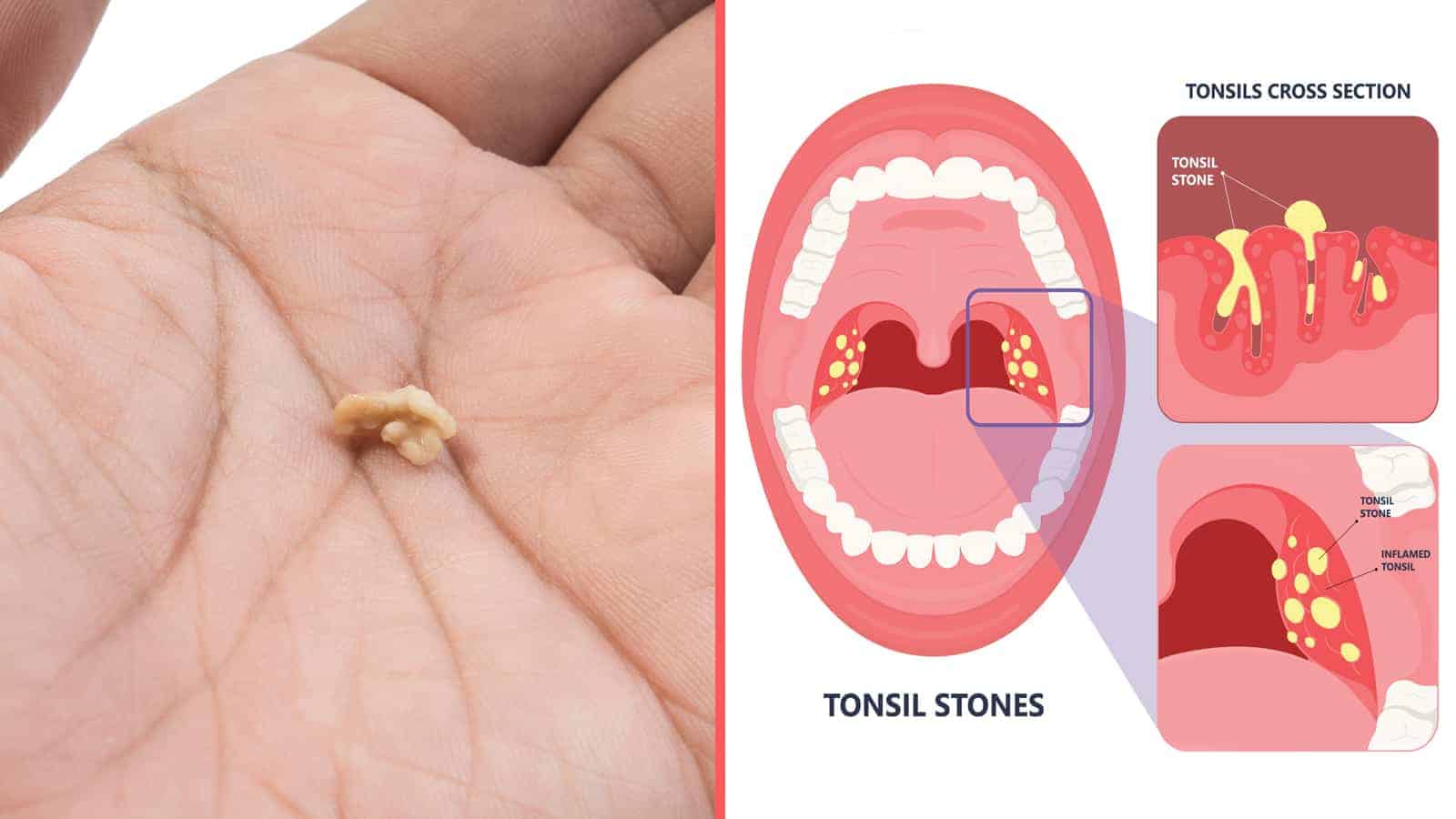If you were to hear someone talk about stones in the body, your mind would automatically wander to the kidneys. However, the kidney isn’t the only area in your system where a nagging stone can develop. Tonsil stones are quite common, and they don’t present near the danger of the other variety.
The medical term for these unsightly rocks is tonsilloliths, according to the National Library of Medicine. They are located on or near the tonsils in the throat, and they have a white or yellowish color about them. They get the term stone because they are hard as a rock. What causes these little pebbles to form in the tonsil area?
The size of the tonsil stone can vary greatly. Some people have stones, no bigger than a kernel of corn, while others might fight some that are as large as a cherry tomato. Thankfully, they’re not known to cause any significant health problems, but they are known for their pungent odor.
In the rare event that these stones become more extensive, they can make the entire area inflamed. When the tonsils swell, it can impede the airway, though this is a worst-case scenario. Most people don’t even need medical treatment as they use home remedies to take care of the problem.
Four Factors That Contribute to Tonsil Stones
You see a little dangling ball of flesh in the back of your throat known as the uvula, and the tonsils are on either side. You cannot see all the pits and tunnels hiding within these little cryptic type areas. Numerous crevices within this region make trapping things like food and dead skin cells effortless.Since everything you swallow goes through this region, it’s not uncommon for things to become trapped within the fissures and start to form a buildup. Sadly, once the area has a collection of materials, bacteria begin feeding on the rotting or decayed matter. It’s easy to tell when you have an issue such as this from the horrible odor that it causes.
A tonsil stone doesn’t form overnight, but as the debris sits in these pockets, they turn rock hard. Now, the exciting part is that you can get one stone or have many at one time. It all depends on your risk factors and the design of your tonsils.
The more crevasse you have, the more likely you are to develop these rock-like formations. The medical community has identified the four most common risk factors, and they are:
1. Lackluster Dental Hygiene
When a person lacks dental hygiene, it causes more bacteria and debris to roam freely around the mouth. It can easily get lodged in these pockets within the tonsils. Once the stone is forming, no amount of brushing or flossing will get rid of it.
2. Abnormal Sized Tonsils
If a dentist measured 50 mouths across the country, all would have different sized tonsils. They’re just as unique as your toes or fingers. Sadly, the larger this gland is, the more likely you will have problems with things getting trapped inside them.
If it continues to be an ongoing problem, you can remove them to avoid the recurring issue.
3. Persistent Sinus Problems
Sinus issues are a known contributor to tonsil stones because of the infection and mucus that washes down the back of the throat. Anytime you have a high bacteria area, plus pockets where food particles can hide, it’s a recipe for trouble.
4. Recurring Tonsillitis
Tonsillitis is an inflammation of the tonsils. It often is accompanied by a sore throat, blisters, and infection. Some people have recurring bouts with this common condition, which puts them more at risk.
Seven Signs of Tonsil Stones
Thankfully, most people can easily see their stones by merely self-examining in the mirror. However, depending on the size and location, you may not be able to identify them quickly. Thankfully, some signs and symptoms are present that cannot be ignored.
1 – Distinct Odor Coming from Your Mouth
The odor caused by tonsil stones is pungent. It smells like that of a rotten tooth or any other type of decay. According to the National Library of Medicine, you might be able to taste the infection and bacteria amongst the saliva in your mouth. Remember, if there is an infection present, you’re swallowing and putting all those germs into your stomach, so this needs to be taken care of immediately.
2 – Sore Throat
Do you have a sore throat that won’t go away? When stones are present, it’s common for there to be swelling and redness. You may think it’s a routine sore throat, but when it lingers, then it’s cause for alarm. The stones can irritate the lining of the throat, causing inflammation.
3 – Difficulties with Swallowing
Depending on the size and location of the stone, you may have difficulty swallowing larger items. Does food seem to get hung up on one side, or do you have to force things down with a drink? These are all signs that the stone is in some way blocking your esophagus.
4 – Nagging Earaches
If you know anything about your medical anatomy, you know that your ears, nose, and throat are connected. When you deal with a sore throat’s chronic issues, then it’s expected that your ears have sympathetic pains. Additionally, you can develop an infection in your ears if the sinuses are involved or the infection in this area travels to other regions.
5 – Chronic Cough
You may cough a lot if you have tonsil stones in your mouth. The reason is that your gag reflex is trying to remove anything in the area down through the digestive system. Anything in the pockets or crevasses and the stones themselves can trigger this reflex and cause you to want to try to expel the foreign bodies.
6 – Distended Tonsils
Since the tonsils collect debris and fill with inflammation, it’s common for you to notice some swelling or inflammation in the area. One tonsil may appear more extensive than the other, especially if it’s the one involved. Only one tonsil can be affected, and the other one can be healthy.
7 – White or Yellow Patches
At first glance, you might think that you have a blister in your throat. Most people don’t look inside their mouths looking for tonsil stones. So, if you’ve identified what you believe is a blister, and it doesn’t go away, then it needs to be investigated further.
*It should be noted that most stones are on the smaller size. In general, these smaller stones don’t cause any pain, sore throats, smells, or other problems. It’s only when the calcifications get to a larger size that they become an issue.
Prevention to Avoid Tonsilloliths
Here are a few things that you can do to help prevent these annoying stones from developing.
•Stay Hydrated
The more water you drink, the less chance there is of any debris lodging in your throat. Water helps to push all the debris in your mouth down through your esophagus.
•Do A Saltwater Gargle
About once a week, you need to do a saltwater gargle. Doing this will help to flush the bacteria as well as help break down any lodged particles. Try using warm water for better results.
•Brush Your Teeth and Tongue Regularly
Brushing your teeth is one of the best defenses against bacteria in the mouth. However, many people forget to brush their tongue. The bacteria on the back of the tongue can be problematic to those who suffer from common stones near the tonsils.
•Quit Smoking
Smoking is a bad habit that can cause both mouth and lung cancer. When you inhale all those carcinogens into your mouth, you’re creating a breeding ground for trouble. Cigarette smoke is toxic to you and those around you.
Final Thoughts on Tonsil Stones
Removing these stones is not tricky. Most people can dislodge them by gargling with warm saltwater. Some people remove them with a water pick or a cotton swab, but the location and size dictate what you can do.
Like using a laser, some more advanced procedures are reserved for more extensive and challenging to reach calcifications. Tonsil stones are a common problem that plagues many people. They don’t become problematic until they’re a larger size that inhibits swallowing and causes infection.
If you have frequent battles with these stones, then you may need to look at various methods to try to prevent them in the future. If you’ve used all the preventative measures listed above and still have no relief, then you might want to consider having your tonsils removed.
According to the National Library of Medicine, a tonsillectomy is a standard procedure the removes the host that allows the debris to lodge and form stones. It’s a minor operation that can bring you permanent relief. If you tend to deal with these calcifications in your mouth, they can be troublesome and need a more permanent solution.



















